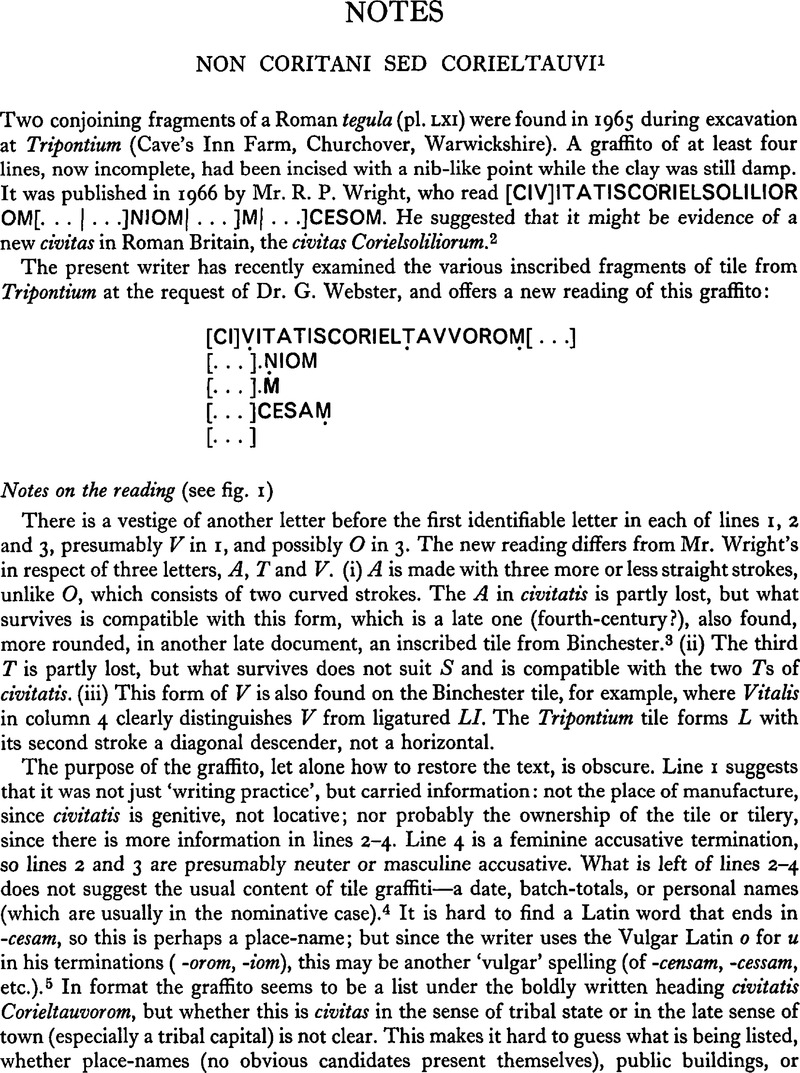No CrossRef data available.
Article contents
Two Decorative Relief Carvings at Lydney Park, Gloucestershire
Published online by Cambridge University Press: 29 November 2011
Abstract

- Type
- Notes
- Information
- Copyright
- Copyright © The Society of Antiquaries of London 1983
References
NOTES
20 I am grateful to Mr. P. J. Casey, director of the recent excavations at Lydney Park, who told me about these stones and invited my comments, and to the Viscount Bledisloe for his permission to examine and publish them.
21 The main reports are: W. H. Bathurst and King, C. W., The Roman Antiquities at Lydney Park, Gloucestershire, Monmouthshire and Caerleon Antiq. Assoc. (1879)Google Scholar; Casey, D. A., ‘Lydney Castle’, Antiq. J. XI (1931), 240–61CrossRefGoogle Scholar; M., R. E. and Wheeler, T. V., Report on the Excavation of the Prehistoric, Roman and Post-Roman Site in Lydney Park, Gloucestershire, Res. Rep. Soc. Antiq. London, IX (1932).Google Scholar
22 Blagg, T. F. C., ‘Roman civilian and military architecture in the Province of Britain: aspects of patronage, influence and craft organisation’, World Arch, XII (1980), 27–42, 31–3.CrossRefGoogle Scholar
23 Toynbee, J. M. C., Art in Britain under the Romans (Oxford, 1964), pp. 191, 197–8 and pls. XLVIIa and XLVIIa.Google Scholar
24 T. Blagg, ‘The sculptured stones’, pp. 125–93 in Hill, C., Millett, M. and Blagg, T., The Roman Riverside Wall and Monumental Arch in London, London and Middlesex Arch. Soc. Special Paper, 3 (1980), p. 156Google Scholar; Cunliffe, B., Roman Bath, Res. Rep. Soc. Antiq. London, XXIV (1969), p. 29.Google Scholar
25 von Massow, W., Die Grabmäler von Neumagen (Berlin and Leipzig, 1932).Google Scholar
26 Toynbee, op. cit. (note 23), pp. 161–2 and pl. XLVa.
27 Cunliffe, op. cit. (note 24), pp. 29–33; Blagg, op. cit. (note 24), pp. 157–67.
28 Blagg, op. cit. (note 24), pp. 153–7 and fig. 84.
29 Blagg, T. F. C., ‘Roman Architectural Ornament in Britain’, University of London, unpublished Ph.D. thesis (1981), pp. 189–91.Google Scholar
30 Cunliffe, B. W. and Fulford, M. G., Corpus Signorum Imperii Romani {Great Britain), I.2: Bath and the Rest of Wessex (1982), no. 83, pl. 21; Cunliffe op. cit. (note 24), no. 2.24.Google Scholar
31 R.C.H.M. (England), London, III: Roman London (1928), pls. 7 and 20.
32 Blagg, op. cit. (note 24), pp. 183–4.
33 C.S.I.R. (G.B.), I.2 (note 30), no. 54, pl. 14; Cunliffe, op. cit. (note 24), pl. LIa.
34 Blagg, T. F. C., ‘Reconstructions of Roman decorated architecture: proportions, prescriptions and practices’, in Drury, P. (ed.), Structural Reconstructions, B.A.R. Brit. Ser. 110 (Oxford, 1982), pp. 131–51.Google Scholar
35 Elliott, W. R., ‘Chest-Tombs and “Tea-Caddies” by Cotswold and Severn’, Trans. Bristol Glos. Arch. Soc. XCV (1977), 68–85.Google Scholar
36 I am grateful to Mr. W. R. Elliott for his information on this point, based on comparison of a photograph and drawing of the Lydney stone with his extensive collection of photo graphs of the tombs in question.
37 See, for example, the tomb of Henry VII in Westminster Abbey by Pietro Torrigiani, executed between 1511 and 1518: Esdaile, K. A., English Church Monuments 1510–1840 (London, 1946), pl. 41.Google Scholar
38 E.g. those of the Julii at St. Rémy and of the Secundinii at Igel: Gabelmann, H., Römiscke Grabbauten der frühen Kaiserzeits (Stuttgart, 1979), Abb. 16, 17, 32.Google Scholar
39 Cunliffe, op. cit. (note 24), 27–8; C.S.I.R. (G.B.), 1.2 (note 30), nos. 29–31, pls. 8 and 9.
40 Furthermore, the twelfth-century castle on Little Camp Hill (infra) appears to have been demolished during the medieval period and produced nothing which could have been of (sc. later than) early medieval date: Casey, op. cit. (note 21), p. 250.
41 Wheeler and Wheeler, op. cit. (note 21), p. 67 and pl. XXIIIa.
42 Bathurst and King, op. cit. (note 21), p. 2; Casey, op. cit. (note 21), p. 240.
43 Bathurst and King, op. cit. (note 21), p. 3. It may be inferred from the absence of mention in this report that they were not found in the Rt. Hon. Charles Bathurst's carefully recorded excavations in 1805.
44 Blagg, T. F. C., ‘Architectural patronage in the western provinces of the Roman Empire in the third century’, in King, A. C. and Henig, M. (eds.), The Roman West in the Third Century, B.A.R. Int. Ser. 109 (Oxford, 1981), 167–88, at p. 170.Google Scholar
45 Note by Casey, P. J. in Grew, F. O., ‘Roman Britain in 1980’, Britannia, XII (1981) 357.Google Scholar




